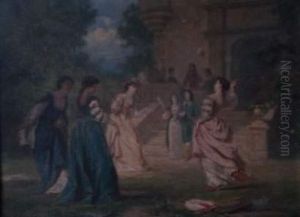Bakalowicz Paintings
Ludwik de Laveaux, known professionally as Ludwik Bakalowicz, was a Polish painter who was born on December 7, 1833, in Lublin, Poland. He was a part of the late 19th-century European art scene, specializing in genre and historical scenes, as well as being recognized for his elegant depiction of the high society of his time.
Bakalowicz studied at the School of Fine Arts in Warsaw and later continued his education in St. Petersburg, Russia, where he became influenced by the Russian realists. In 1863, he moved to Paris, which was then the epicenter of the art world. There, he was greatly influenced by French academic painting, and he came to be associated with the French academic art movement.
While in Paris, Bakalowicz became part of the city’s vibrant Polish expatriate community. He exhibited his work at the Paris Salon, the annual art exhibition of the Académie des Beaux-Arts in Paris, which was the most prestigious art event at the time. His paintings often depicted scenes from Polish history and literature, which resonated with his fellow countrymen and the broader European audience curious about Poland's past and culture.
Bakalowicz’s works were recognized for their fine detail, rich color palette, and the ability to capture the textures of luxurious fabrics and materials. He often painted scenes of 17th and 18th-century European aristocracy, showing a fondness for the lavish and decadent lifestyle of the time. His portrayal of historical subjects was marked by a romanticized elegance, which made his paintings popular among art collectors.
After a fruitful career, Ludwik Bakalowicz died on February 1, 1903, in Paris, France. His paintings can be found in various art collections and have been displayed in museums around the world. Despite the fact that he is not as widely known today as some of his contemporaries, his works remain a testament to his skill as a painter and his role in the 19th-century European art world.
